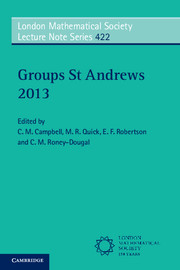Book contents
- Frontmatter
- Contents
- INTRODUCTION
- Approximate subgroups and super-strong approximation
- Width questions for finite simple groups
- Profinite properties of discrete groups
- GL(n, Z), Out(Fn) and everything in between: automorphism groups of RAAGs
- Permutation groups and transformation semigroups: results and problems
- New progress on factorized groups and subgroup permutability
- A survey on the normalizer problem for integral group rings
- A survey on Clifford-Fischer theory
- A generalisation on the solvability of finite groups with three class sizes for normal subgroups
- Automorphism groups of non-orientable Riemann surfaces
- What are the C2-groups?
- Resurrecting Wells’ exact sequence and Buckley's group action
- Recent work on Beauville surfaces, structures and groups
- Something for nothing: some consequences of the solution of the Tarski problems
- The groups of projectivities in finite planes
- On the relation gap and relation lifting problem
- Some results on products of finite subsets in groups
- Formal languages and group theory
- On the Castelnuovo-Mumford regularity of the cohomology of fusion systems and of the Hochschild cohomology of block algebras
- Recent advances on torsion subgroups of integral group rings
- On finite groups with small prime spectrum
- Solvability criteria for finite loops and groups
- The rational subset membership problem for groups: a survey
- A survey of Milnor laws
- Capable p-groups
- On the normal structure of a finite group with restrictions on the maximal subgroups
- Certain monomial characters and their normal constituents
- Recognition of finite quasi-simple groups by the degrees of their irreducible representations
- Generalized Baumslag-Solitar groups: a survey of recent progress
- Zeta functions of groups and rings – recent developments
Resurrecting Wells’ exact sequence and Buckley's group action
Published online by Cambridge University Press: 05 September 2015
- Frontmatter
- Contents
- INTRODUCTION
- Approximate subgroups and super-strong approximation
- Width questions for finite simple groups
- Profinite properties of discrete groups
- GL(n, Z), Out(Fn) and everything in between: automorphism groups of RAAGs
- Permutation groups and transformation semigroups: results and problems
- New progress on factorized groups and subgroup permutability
- A survey on the normalizer problem for integral group rings
- A survey on Clifford-Fischer theory
- A generalisation on the solvability of finite groups with three class sizes for normal subgroups
- Automorphism groups of non-orientable Riemann surfaces
- What are the C2-groups?
- Resurrecting Wells’ exact sequence and Buckley's group action
- Recent work on Beauville surfaces, structures and groups
- Something for nothing: some consequences of the solution of the Tarski problems
- The groups of projectivities in finite planes
- On the relation gap and relation lifting problem
- Some results on products of finite subsets in groups
- Formal languages and group theory
- On the Castelnuovo-Mumford regularity of the cohomology of fusion systems and of the Hochschild cohomology of block algebras
- Recent advances on torsion subgroups of integral group rings
- On finite groups with small prime spectrum
- Solvability criteria for finite loops and groups
- The rational subset membership problem for groups: a survey
- A survey of Milnor laws
- Capable p-groups
- On the normal structure of a finite group with restrictions on the maximal subgroups
- Certain monomial characters and their normal constituents
- Recognition of finite quasi-simple groups by the degrees of their irreducible representations
- Generalized Baumslag-Solitar groups: a survey of recent progress
- Zeta functions of groups and rings – recent developments
Summary
Abstract
We give a historical perspective on the Wells exact sequence and Buckley's interpretation of it, and include a survey of applications and extensions of their work from the 1970's to the present.
Introduction
In 1971, CharlesWells [26] constructed an exact sequence for the automorphism group of a group extension. The paper received a bit of attention at the time, but seems to have been largely ignored until the last decade. In particular, a series of papers in the Journal of Algebra over the last few years (see [12], [13], [16]) have brought attention to the sequence and its applications.
This paper presents a historical view of the Wells exact sequence, emphasizing the game-changing nature of Joseph Buckley's interpretation of Wells’ result in the context of group actions. Indeed, one goal of this paper is to give Buckley credit–at least equal to Wells–for describing an invaluable method for investigating automorphisms of group extensions. A survey of applications of Wells’ and Buckley's work is provided.
The paper is organized as follows: Section 2 begins with background information on group extensions and their automorphisms; Section 3 focuses on the 1970's and gives a history of Wells’ work and subsequent papers by Buckley and others; Section 4 focuses on the “resurrection” of Wells’ and Buckley's work in the last decade, but does not contain detailed statements of theorems; and Section 5 concludes with a survey of applications and extensions of the Wells exact sequence, including details missing in Section 4.
Background Information
In this section we give background information on group extensions and their automorphisms. This information is well known and available in many other places, but we will use this opportunity to establish some notation. For group extensions, we will follow the notation in [20] as closely as possible since Derek Robinson's book is widely available, and because both the book and an old paper of his [18] are commonly used resources by those in the field.
- Type
- Chapter
- Information
- Groups St Andrews 2013 , pp. 209 - 224Publisher: Cambridge University PressPrint publication year: 2015
- 3
- Cited by



